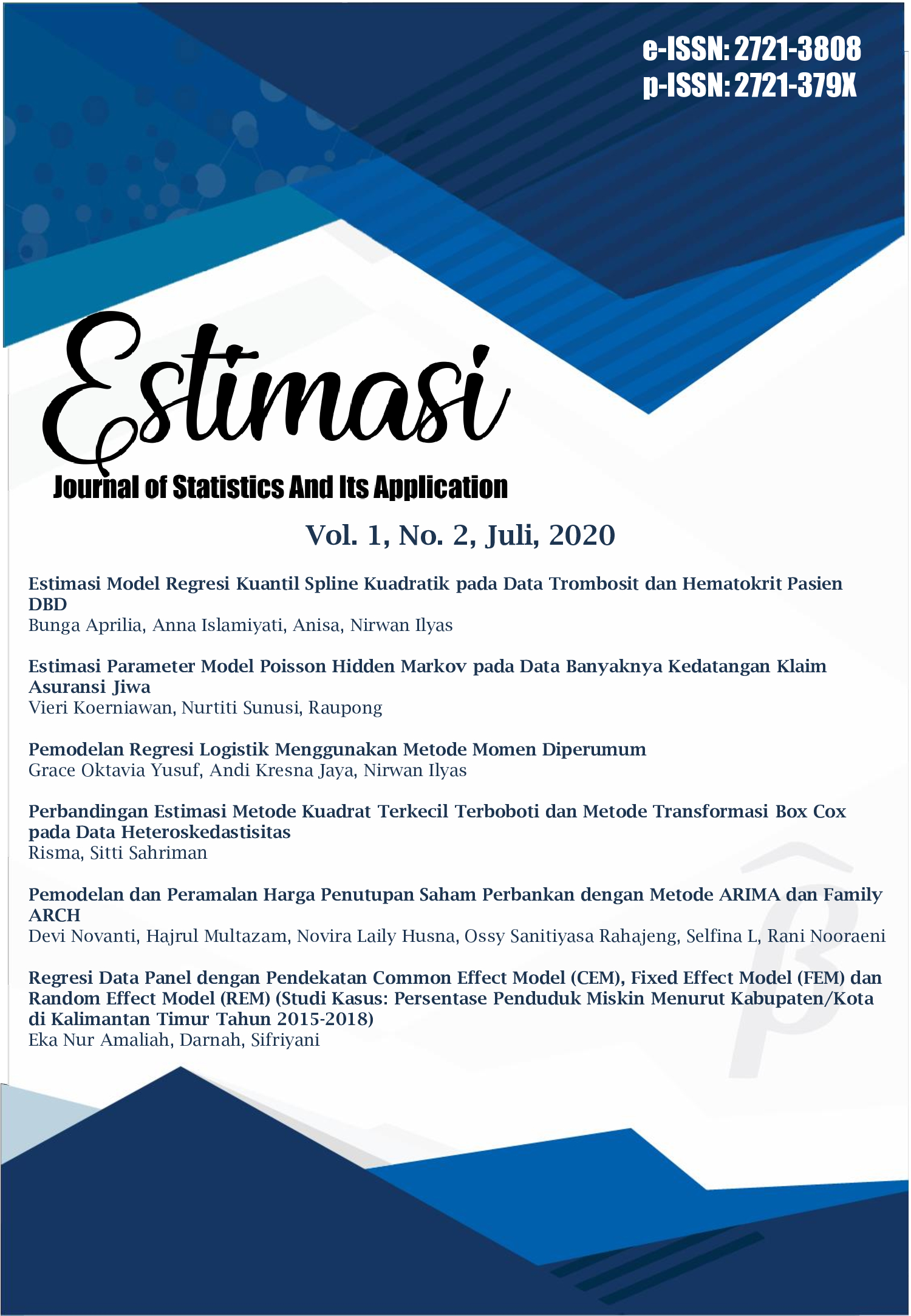Regresi Data Panel dengan Pendekatan Common Effect Model (CEM), Fixed Effect model (FEM) dan Random Effect Model (REM) (Studi Kasus: Persentase Penduduk Miskin Menurut Kabupaten/Kota di Kalimantan Timur Tahun 2015-2018)
DOI:
https://doi.org/10.20956/ejsa.v1i2.10574Keywords:
04032017Abstract
Panel data regression is a regression that combines cross section data and time series data. Panel data regression estimation can be done through 3 estimates namely CEM, FEM and REM. This research will make a modeling of the percentage of poor people according to regencies / cities in East Kalimantan using panel data regression analysis. Poverty occurs due to lack of income and assets to meet basic needs. For this reason, variables that are assumed to affect the percentage of the poor are used, including the Population Growth Rate (LPP), Human Development Index (HDI), and Adjustable Per capita Expenditure (PPD). By using 3 CEM, FEM and REM approaches based on testing, the best FEM model is obtained. Based on the FEM model the factors that significantly influence are the HDI and PPD. A value of 0.7755 means that the HDI and PPD can explain the percentage of poor people according to the Regency / City in East Kalimantan of 77.55% while the remaining 22.45% is influenced by other variables not yet included in the model.
References
Baltagi, B. H. Econometrics Analysis of Panel Data Third Edition. Great Britain: Anthony Rowe Ltd, Chippenham, Wiltshire, 2005.
BPS Indonesia. Berita Resmi Statistik Profil Kemiskinan di Indonesia
September 2018, 2019.
Greene. William H. Econometrics Analysis 6th Edition. New Jersey:
Prentice Hall, 2007.
Gujarati, Damodar N. Basic Econometrics Fourth Edition. New York: The McGraw-Hill Companies, 2004.
Gujarati, Damodar N. Dasar-dasar Ekonometrika. Terjemahan: Mangunsong, R. C. Jakarta: Salemba Empat, 2012.
Harinaldi. Prinsip-prinsip Statistik untuk Teknik dan Sains. Jakarta: Erlangga, 2005.
Hsiao, C. Analysis Of Panel Data.Cambridge. Southern California: University Press, 2003.
Setiawan & Kusrini. Ekonometrika. Yogyakarta: Penerbit ANDI, 2010.
Susanti, Sussy. Pengaruh Produk Domestik Regional Bruto, Pengangguran dan Indeks Pembangunan Manusia terhadap Kemiskinan di Jawa Barat dengan Menggunakan Analisis Data Panel. Jurnal Matematika Integratif, 9(1), 1-18, 2013.
Widarjono, Agus. Ekonometrika Teori dan Aplikasi untuk Ekonomi dan Bisnis. Yogyakarta: Ekonisia FE UII, 2007.
Widarjono, Agus. Ekonometrika: Pengantar dan Aplikasinya. Yogyakarta: Ekonisia, 2009.
World Bank. Era Baru dalam Pengetasan Kemiskinan di Indonesia. Jakarta: Gradasi Aksara, 2006.
Hufaini, A.S.F.R, Raupong, & Ilyas, N. Regresi Model Data Panel Efek Tetap dengan Metode Within Group pada Data Indeks Pembangunan Manusia Provinsi Sulawesi Selatan. ESTIMASI: Journal of Statistics and Its Application, 1(1), 10-20, 2020.
Downloads
Published
Versions
- 2022-02-02 (3)
- 2022-02-02 (2)
- 2022-02-02 (1)
Issue
Section
License
Copyright
It is the author's responsibility to ensure that his or her submitted work does not infringe any existing copyright. Authors should obtain permission to reproduce or adapt copyrighted material and provide evidence of approval upon submitting the final version of a manuscript.


